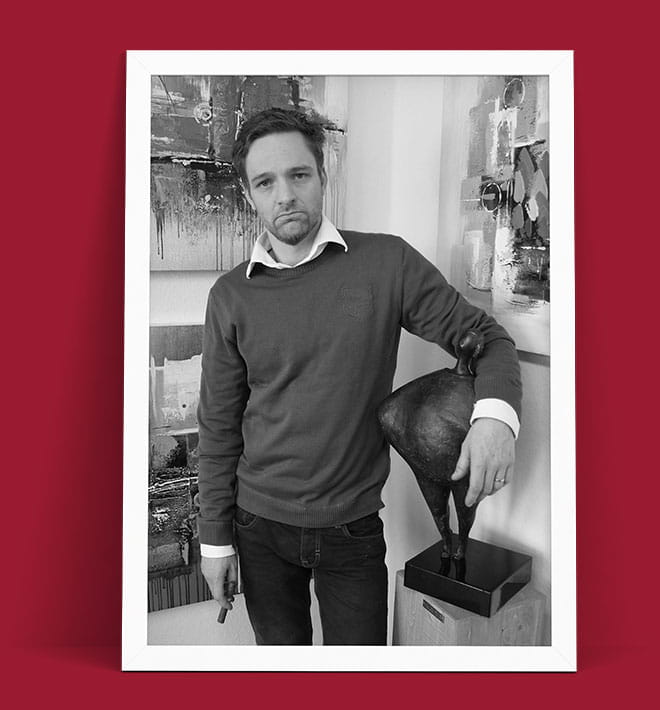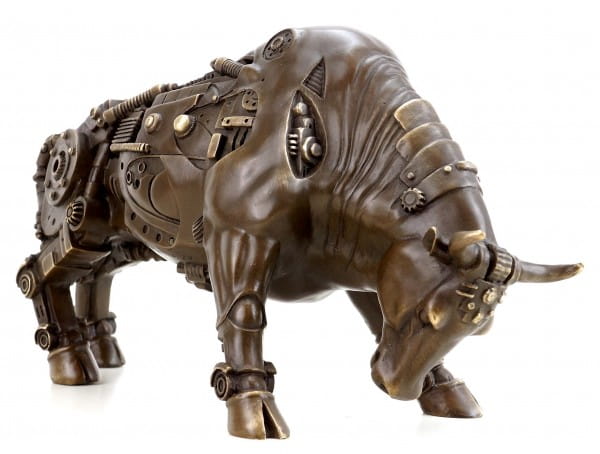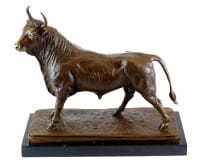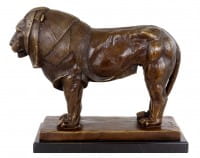€1,299.00 *
Prices incl. VAT, free shipping worldwide
Ready to ship today,
Delivery time appr. 3-6 workdays










Steampunk Bull – A Limited Edition Bronze Bull Sculpture - Signed Martin Klein Martin Klein... more
Product description
"Steampunk Statue - Bronze Bull Sculpture - Martin Klein"
| Weight | 5,4 kg |
Steampunk Bull – A Limited Edition Bronze Bull Sculpture - Signed Martin Klein
Martin Klein born 1979, beneath the slate roofs of Bischofswerda, a small Saxon town where medieval streets mix with whispering pine forests. Even as a child, he wandered between ancient Baroque churches and quiet pastures, sketching draft horses in their sturdy grace and marveling at the intricate gears of his grandfather’s clock. In these formative years, he learned to see poetry in machines and soul in animals—an early revelation that would steer him toward a life in sculptural form.
From Dresden Academia to Leipzig Studios
Klein’s adolescence led him to enroll at the Dresden Academy of Fine Arts, where he immersed himself in classical technique while nurturing a fascination for modern industrial aesthetics. He studied anatomy by day and, by night, sketched fantastical contraptions that married gears, pistons, and sinew. The artist had established a modest atelier in a repurposed textile mill in Leipzig—a space marked by high ceilings and ample sunlit windows, where clay cones and bronze patinas stood alongside sketches of horses and clockwork mechanisms.
Conception of a Steampunk Vision
He recalled the powerful draft horses of his youth—beasts of burden whose hooves thundered across fields—and imagined a creature even more formidable, one fused with steam-driven technology. Sketching late into the night, he honed a vision: a bull whose muscular form is interlaced with exposed gears and brass rivets, whose stance suggests unyielding strength even as mechanical components speak of ingenuity and innovation. This was to be a bronze bull sculpture that stood not merely as an homage to natural power but as a testament to the creative alchemy of machine and beast.
Modeling a Modern Myth in Clay
Klein had erected an elevated worktable in the Leipzig workshop and began sculpting a full-sized bull from clay. His hands shaped every sinew of the shoulder and hip, then carved away sections of hindquarters to make room for swirling gears and pistons. The bull’s head—tilted slightly downward in a challenge—revealed swirling mechanical plates embedded where flesh would normally contour. A funnel-shaped cheek armor suggested ventilation for hidden steam chambers. Klein spent weeks refining the mechanical motifs: coiled springs around the hooves, pipe-like structures along the spine, and a filigree of brass rods arching across the neck. Every incision hinted at function as much as form, creating subtle creases in the animal’s skin that seem to breathe beneath cold metal.
Martin Klein born 1979, beneath the slate roofs of Bischofswerda, a small Saxon town where medieval streets mix with whispering pine forests. Even as a child, he wandered between ancient Baroque churches and quiet pastures, sketching draft horses in their sturdy grace and marveling at the intricate gears of his grandfather’s clock. In these formative years, he learned to see poetry in machines and soul in animals—an early revelation that would steer him toward a life in sculptural form.
From Dresden Academia to Leipzig Studios
Klein’s adolescence led him to enroll at the Dresden Academy of Fine Arts, where he immersed himself in classical technique while nurturing a fascination for modern industrial aesthetics. He studied anatomy by day and, by night, sketched fantastical contraptions that married gears, pistons, and sinew. The artist had established a modest atelier in a repurposed textile mill in Leipzig—a space marked by high ceilings and ample sunlit windows, where clay cones and bronze patinas stood alongside sketches of horses and clockwork mechanisms.
Conception of a Steampunk Vision
He recalled the powerful draft horses of his youth—beasts of burden whose hooves thundered across fields—and imagined a creature even more formidable, one fused with steam-driven technology. Sketching late into the night, he honed a vision: a bull whose muscular form is interlaced with exposed gears and brass rivets, whose stance suggests unyielding strength even as mechanical components speak of ingenuity and innovation. This was to be a bronze bull sculpture that stood not merely as an homage to natural power but as a testament to the creative alchemy of machine and beast.
Modeling a Modern Myth in Clay
Klein had erected an elevated worktable in the Leipzig workshop and began sculpting a full-sized bull from clay. His hands shaped every sinew of the shoulder and hip, then carved away sections of hindquarters to make room for swirling gears and pistons. The bull’s head—tilted slightly downward in a challenge—revealed swirling mechanical plates embedded where flesh would normally contour. A funnel-shaped cheek armor suggested ventilation for hidden steam chambers. Klein spent weeks refining the mechanical motifs: coiled springs around the hooves, pipe-like structures along the spine, and a filigree of brass rods arching across the neck. Every incision hinted at function as much as form, creating subtle creases in the animal’s skin that seem to breathe beneath cold metal.
Lost-Wax Casting in Saxon Tradition
The clay original was carefully transported to a storied foundry in Saxony’s Ore Mountains, where generations of artisans still perform the ancient lost-wax casting process. Encased in a ceramic shell, the intricate bull model received a wax cast, which was then melted away to create a hollow for molten bronze. Heated to over 1,150 degrees Celsius, the bronze filled every detail—from the delicate coil of a pressure valve to the subtly carved nick in the bull’s mechanical jaw. Once cooled, skilled craftsmen removed the ceramic mold, unveiling a raw bronze form that bore the promise of both brute strength and fine-tuned mechanics.
Chasing, Patination, and Polishing
After casting, Klein oversaw the delicate phase known as chasing. Seam lines from the mold were meticulously erased, and surfaces were refined until the bronze’s textures flowed without interruption. A layered patina followed: initially, a rich umber wash settled into the deepest crevices, lending depth to the bull’s musculature. Using selective burnishing, Klein revealed warmer highlights on the edges of pipes and plates, evoking the warm glow of heated metal. Final touches involved polishing the mechanical coils along the legs, ensuring that as light glides across the bull’s flank, the interplay of matte shadows and gleaming ridges evokes a living, breathing steampunk creature.
Symbolism of Unity Between Nature and Machine
Beyond its visceral impact the Steampunk statue represents a deeper metaphor: the potential harmony between the natural world and human ingenuity. In Klein’s vision, the bull is not enslaved to its mechanical augmentations but elevated by them—each gear and pipe enhancing its inherent power rather than detracting from it. This unity suggests that progress need not abandon tradition, that technology and nature can coexist in a symbiotic dialogue. As the bull stands poised to charge forward, it reminds us that our own creative engines can be harnessed to amplify, rather than diminish, the living wonders around us.
A Limited Edition of Twenty Masterpieces
To preserve the sculpture’s exclusivity, Klein limited the Steam Punk Bull to just twenty signed casts. As a bronze bull sculpture, this piece is destined for collectors who appreciate artistry that bridges classical skill and imaginative vision. Over the years, the patina may deepen and soften, allowing brass highlights to gain warmth and dark shadows to invite closer inspection.
Presence in Any Curated Environment
Whether displayed in a minimalist loft or a traditional study, the Steam Punk Bull asserts a powerful presence without overwhelming its surroundings. Its intricate details invite viewers to walk around it, observing how an artist’s hand has melded flesh and piston into a single, vibrant form. Under a single overhead spotlight, the ridged plates cast dramatic shadows; in natural light, the interplay of matte and polished bronze dances with shifting daylight. For interior designers seeking a focal piece that sparks conversation and commands admiration, this steam punk statue delights the eye and challenges the mind.
The clay original was carefully transported to a storied foundry in Saxony’s Ore Mountains, where generations of artisans still perform the ancient lost-wax casting process. Encased in a ceramic shell, the intricate bull model received a wax cast, which was then melted away to create a hollow for molten bronze. Heated to over 1,150 degrees Celsius, the bronze filled every detail—from the delicate coil of a pressure valve to the subtly carved nick in the bull’s mechanical jaw. Once cooled, skilled craftsmen removed the ceramic mold, unveiling a raw bronze form that bore the promise of both brute strength and fine-tuned mechanics.
Chasing, Patination, and Polishing
After casting, Klein oversaw the delicate phase known as chasing. Seam lines from the mold were meticulously erased, and surfaces were refined until the bronze’s textures flowed without interruption. A layered patina followed: initially, a rich umber wash settled into the deepest crevices, lending depth to the bull’s musculature. Using selective burnishing, Klein revealed warmer highlights on the edges of pipes and plates, evoking the warm glow of heated metal. Final touches involved polishing the mechanical coils along the legs, ensuring that as light glides across the bull’s flank, the interplay of matte shadows and gleaming ridges evokes a living, breathing steampunk creature.
Symbolism of Unity Between Nature and Machine
Beyond its visceral impact the Steampunk statue represents a deeper metaphor: the potential harmony between the natural world and human ingenuity. In Klein’s vision, the bull is not enslaved to its mechanical augmentations but elevated by them—each gear and pipe enhancing its inherent power rather than detracting from it. This unity suggests that progress need not abandon tradition, that technology and nature can coexist in a symbiotic dialogue. As the bull stands poised to charge forward, it reminds us that our own creative engines can be harnessed to amplify, rather than diminish, the living wonders around us.
A Limited Edition of Twenty Masterpieces
To preserve the sculpture’s exclusivity, Klein limited the Steam Punk Bull to just twenty signed casts. As a bronze bull sculpture, this piece is destined for collectors who appreciate artistry that bridges classical skill and imaginative vision. Over the years, the patina may deepen and soften, allowing brass highlights to gain warmth and dark shadows to invite closer inspection.
Presence in Any Curated Environment
Whether displayed in a minimalist loft or a traditional study, the Steam Punk Bull asserts a powerful presence without overwhelming its surroundings. Its intricate details invite viewers to walk around it, observing how an artist’s hand has melded flesh and piston into a single, vibrant form. Under a single overhead spotlight, the ridged plates cast dramatic shadows; in natural light, the interplay of matte and polished bronze dances with shifting daylight. For interior designers seeking a focal piece that sparks conversation and commands admiration, this steam punk statue delights the eye and challenges the mind.
Height: 20.0 cm
Width: 36.0 cm
Depth: 14.5 cm
Weight: 5.4 kg
Width: 36.0 cm
Depth: 14.5 cm
Weight: 5.4 kg
Related links to "Steampunk Statue - Bronze Bull Sculpture - Martin Klein"
Read, write and discuss reviews... more
Customer evaluation for "Steampunk Statue - Bronze Bull Sculpture - Martin Klein"
Write an evaluation
Evaluations will be activated after verification.
Our advantages
free shipping
Worldwide free shipping
14 days money back
You can cancel your order
within 14 days
secure payment services
Paypal, Master Card, Visa, American Express and more
NEW



































